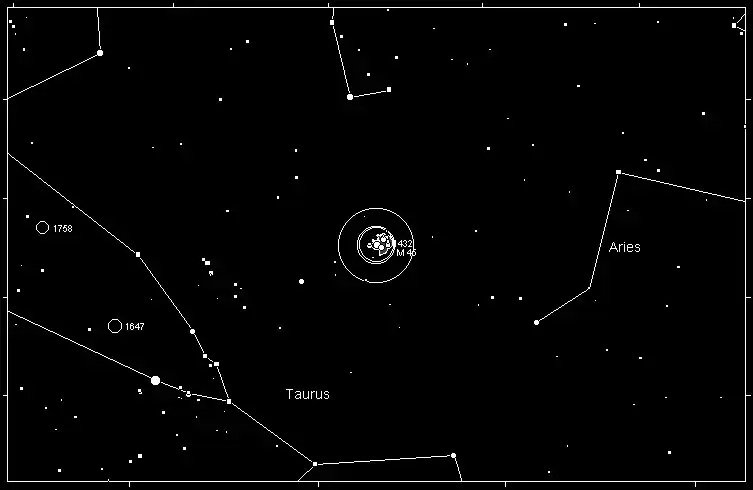Messier 45, commonly known as the Pleiades or the Seven Sisters, is one of the most famous open star clusters in the night sky. It is located in the constellation Taurus and is easily visible to the naked eye. The Pleiades consists of several hundred stars, but the brightest seven are most prominent, giving the cluster its name. These stars are young, hot, and blue, surrounded by a faint reflection nebula caused by interstellar dust reflecting the stars' light.
Magnitude
The Pleiades has an apparent magnitude of 1.6, making it one of the brightest and most recognizable star clusters visible from Earth. Its brightness allows it to be seen even from light-polluted areas, though the full beauty of the cluster is best appreciated in darker skies.

Season of Prominence
The Pleiades is best observed in the winter months in the Northern Hemisphere. It rises in the east during the autumn evenings, reaches its highest point in the sky during winter, and sets in the west by spring. The cluster is most visible and prominent from October to March, with its peak visibility occurring in December.
Constellation
Messier 45 is located in the constellation Taurus, the Bull. Taurus is a zodiacal constellation, meaning it lies along the ecliptic path that the Sun, Moon, and planets travel across the sky. The Pleiades is situated near the Bull’s shoulder and is one of the most identifiable features of this constellation.
How to Find It
Finding the Pleiades is relatively easy due to its brightness and size. Here’s a simple guide to locating it:
- Locate the Constellation Taurus: Look for the prominent "V" shape of the constellation Taurus, which represents the Bull’s face. The bright star Aldebaran marks one of the Bull’s eyes.
- Move North-West: From Aldebaran, move your gaze northwest (upward and slightly to the left). You should soon notice a small, bright grouping of stars.
- Use Binoculars or a Wide-Field Telescope: While the Pleiades can be seen with the naked eye, using binoculars or a telescope with a wide field of view will reveal more stars and some of the surrounding nebulosity. The cluster’s stars appear like diamonds scattered across a velvet sky, with a subtle bluish hue surrounding them.
- Adjust Focus: If using a telescope, start with the lowest magnification to capture the entire cluster in your field of view. Once centered, you can increase magnification slightly to examine individual stars, but the Pleiades is best enjoyed at lower magnifications due to its size.

History
The Pleiades has been known since ancient times and is steeped in mythology across various cultures. In Greek mythology, the cluster is named after the seven daughters of the Titan Atlas and the Oceanid Pleione, who were turned into stars by Zeus to escape the pursuit of the hunter Orion. This mythological connection is further reflected in the night sky, as the constellation Orion appears to chase Taurus and the Pleiades.
In other cultures, the Pleiades has been associated with agricultural calendars and navigation. For example, the Maori of New Zealand call the cluster Matariki, and its appearance in the dawn sky marks the beginning of the Maori New Year. Similarly, in Japan, the Pleiades is known as Subaru, a name that has also been adopted by the famous car manufacturer, whose logo features six stars representing the cluster.
The Pleiades was officially cataloged by the French astronomer Charles Messier in 1771 as the 45th object in his famous catalog of "nebulous" objects. Messier’s catalog was originally compiled to help astronomers distinguish these objects from comets, and the inclusion of the Pleiades highlights its prominence and significance in the night sky.
Conclusion
Messier 45, the Pleiades, is a jewel of the winter sky, captivating observers with its brilliant blue stars and rich history. Whether viewed with the naked eye, through binoculars, or a telescope, the Pleiades continues to inspire awe and wonder across the world. Its visibility throughout human history has ensured that it remains a significant and celebrated feature in both astronomical and cultural contexts.
